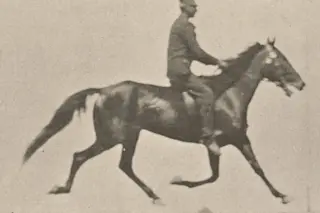This 19th-century image shows a horse pacing. Note that the legs on each side move at the same time. (Credit: USC Digital Library/Wikimedia Commons) Horses normally move about in one of three ways: they walk, trot or gallop. The middle gait, the trot, is a horse's Goldilocks stride — not so fast that it gets tired, but not so slow that it gets left in the dust. Unfortunately for the humans that like to ride on horses' backs, the trot is a pretty uncomfortable gait. During a trot, a horse will lift two legs at a time in diagonal pairs, alternating sets as it goes. This is a very economical motion for the horse, as it requires little extraneous compensation to stay balanced. If you happen to be sitting astride that horse, however, it feels more like riding in a truck with no shocks over a backcountry road — bouncy ...
A Single Mutation Made It Easier to Ride Horses
Gaited horses exhibit a comfortable horse ride with their unique amble gait, differing from the traditional trot. Discover more!
More on Discover
Stay Curious
SubscribeTo The Magazine
Save up to 40% off the cover price when you subscribe to Discover magazine.
Subscribe













